|
Vostochny spaceport After quarter of a century of planning, a decade of design and half a decade of construction, Russia's new spaceport intended to replace Baikonur witnessed its inaugural orbital launch on April 28, 2016.
|
||||||||
| DEVELOPMENT HISTORY | |||||||||
|
|
||||||||
 |
Before Vostochny there was Svobodny After the collapse of the USSR in 1991, Russian government made plans for building a new space launch site at the disused missile base near Svobodny in the nation's Far East to replace Baikonur in newly independent Kazakhstan. However no money could be found for the project, until booming oil prices refilled Kremlin's coffers. |
||||||||
 |
2007: The decision After months of preliminary studies, the Russian president Vladimir Putin formally approved the construction of Vostochny with Decree No. 1473 signed on November 6. However, the Kremlin was yet to allocate a budget for the costly undertaking. |
||||||||
 |
2008: The paperwork In February, Roskosmos approved the "Plan of priority actions for the implementation of the Presidential Decree on the Vostochny development." On June 20, the Presidium of the Scientific and Technical Council at Roskosmos evaluated and approved the system project for the Vostochny launch site. |
||||||||
 |
2009: The money The Russian government finally issued its own approval (Order No. 30-r) for the construction of Vostochny on January 14. On September 1, the Kremlin awarded the entire construction project to its military agency Spetsstroi and allocated funding for the development of the Rus-M rocket for Vostochny. |
||||||||
 |
2010: The final commitment After three years of doubts, President Putin made an official commitment to fund the construction of the new launch site. On June 26, Roskosmos responded with an authorization No. 104, on the organization of the work for the construction of Vostochny facilities. Despite promises and plans, the work at the site did not start. |
||||||||
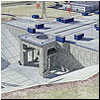 |
2011: Change of plans In 2011, Roskosmos cancelled the Rus-M project, leaving the future spaceport without a rocket to launch. Pressed by the Kremlin to find a solution, the agency had no other ideas but to build another launch pad for the Soyuz rocket. First construction activities in Vostochny finally began in the fall but were moving ahead slowly. |
||||||||
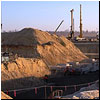 |
2012: Digging the foundation According to the official documentation, the construction of the first phase of the Soyuz-2 processing complex at Site 2 officially started in May 2012 and was scheduled for completion in September 2015. |
||||||||
|
In 2013, the familiar concrete structure of the giant launch pad for the Soyuz rocket started rising from its foundation in Vostochny. Multiple support facilities were also under construction. |
|||||||||
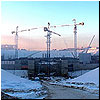 |
During 2014, a concrete structure of the Soyuz pad was mostly completed. Elsewhere around the space center, technical processing facilities, residential area and administrative buildings were also taking shape. |
||||||||
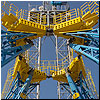 |
During 2015, the construction of the Soyuz pad at Russia's newest space center was scheduled to be completed to host the first launch before the end of the year. However in October, the Kremlin finally admitted that the inaugural launch from the new spaceport would have to be delayed until the following year. |
||||||||
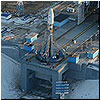 |
2016: Preparing for the first launch From March 21 to March 25, Soyuz-2-1a rocket was tested on its brand new launch pad, opening door to the first mission from Vostochny on April 27, or nearly a decade after the last rocket flew from a near-by site. A Soyuz successfully delivered three satellites into orbit on April 28. |
||||||||
| SOYUZ LAUNCH COMPLEX, Site 1S | |||||||||
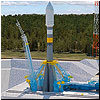 |
Specifically for its use in Vostochny, the Soyuz-2 family was expected to get modest internal updates to enable the fueled rocket to remain on the launch pad for up to 100 hours and withstand the rigors of transportation up to 10,000 kilometers from its manufacturing plant in Samara to the Russian Far East. |
||||||||
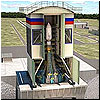 |
The launch complex for the Soyuz-2 rocket in Vostochny, designated 371SK14, featured a "classic" pad for this veteran rocket. Up to 50 companies around Russia supplied equipment for the launch pad, which would include 83 structures and 52 different systems. |
||||||||
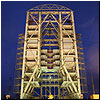 |
Painted in elegant blue and white and standing almost 50 meters high, the Mobile Service Tower, MBO (for Mobilnaya Bashnya Obsluzhivaniya), is designed to provide personnel access to the Soyuz rocket during the countdown to liftoff from its launch pad in Vostochny. The structure can be also used to service the pad after launch and to process the rocket in case of an aborted liftoff. |
||||||||
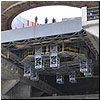 |
Following the delivery of the Soyuz rocket to the launch pad, the Service Cabin, KO (a Russian abbreviation for "Kabina Obslyzhnivaniya"), moves into position around the wide base of the rocket under the launch pad. A series of access bridges then are deployed and raised vertically to form a three-level scaffolding just inches from the vehicle. |
||||||||
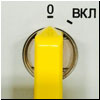 |
The famous "klyuch na start" (key to launch) command for Soyuz rockets in Vostochny is given from a brand-new blockhouse sporting more-than-half-a-meter-thick walls. Located less than half a kilometer from the launch pad, the windowless structure became the nerve center responsible for firing the rocket. |
||||||||
| ANGARA LAUNCH COMPLEX, Site 1A | |||||||||
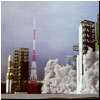 |
After the cancellation of the Rus-M project in 2011, Russian space agency hatched plans to bring the Angara launch vehicle to Vostochny. The launch facility, designated 1A, could be built at the same site that was originally eyed for the Rus-M's dual pad. |
||||||||
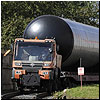 |
After many delays, Roskosmos finally began the construction activities at the future launch facility for the Angara-5 rocket at the end of 2018. |
||||||||
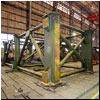 |
2019: Excavation begins, first concrete poured In 2019, despite major organizational issues, earth-moving equipment finally began excavating foundations for key facilities of the Angara pad in Vostochny and, by the end of summer, the first concrete was laid at the site. |
||||||||
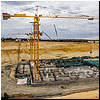 |
2020: Concrete work progresses (INSIDER CONTENT) During 2020, construction crews continued laying concrete at key facilities of the future Angara launch complex in Vostochny, while Roskosmos said that the transition to the installation of equipment began in May. The assembly of the metal structure of the launch table was promised to begin in September, with the aim of completing the construction by 2023. |
||||||||
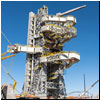 |
2023: Angara pad in Vostochny nears completion (INSIDER CONTENT) During 2021 and 2022, the construction of the key concrete structures for the Angara pad in Vostochny had been largely completed and workers began erecting metal structures and installing various systems inside some of the buildings. First tests of the equipment started in 2023 and the work continued seemingly unaffected by the war. |
||||||||
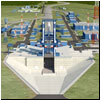 |
Facility 1: Angara launch complex (INSIDER CONTENT) The heart of the newly constructed Angara launch complex in Vostochny is Facility 1, which includes a massive concrete launch pad mostly buried below ground and topped with a metal access and fueling structure, KZB, towering 66 meters above. The pad is flanked by multiple support facilities spreading south on both sides of the main railway linking it to the assembly and processing building. |
||||||||
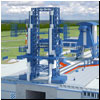 |
Umbilical and Fueling Tower, KZB (INSIDER CONTENT) By the Fall of 2023, workers had mostly completed the landmark structure at the future launch pad for the Angara rocket family. The 60-meter tower will deliver propellant components to all stages of the rocket and provide access to the vehicle for service personnel and future cosmonauts. |
||||||||
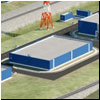 |
Facility 2: Angara's fire station (INSIDER CONTENT) The Angara launch facility includes a pumping station designed to support a sprawling fire-suppression network and also to provide water for every day use across the launch complex. |
||||||||
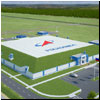 |
Facility 3: Angara's firing room (INSIDER CONTENT) The newly completed launch facility for the Angara rocket family in Vostochny was designed to have a massive blast-protected command and control blockhouse, also known as Facility 3. It is likely the largest "firing room" in the Russian space program, rivaling Soviet-era control bunkers for the Energia super-heavy rocket. |
||||||||
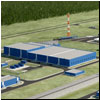 |
Facility 4: Angara's high-pressure farm (INSIDER CONTENT) Somewhat unexpectedly, the largest building supporting Angara launch operations on the pad in Vostochny provides pressurized gases to the rocket rather than propellant. The site, known as "centralized facility," uses common systems for delivering compressed air, nitrogen and helium to the launch pad. |
||||||||
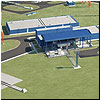 |
Facility 5: Angara's hydrogen infrastructure (INSIDER CONTENT) To fuel prospective upper stages of the Angara rocket family equipped with hydrogen-burning engines, such as the KVTK space tug, the Angara's pad in Vostochny needed a hydrogen fueling facility along with an associated support infrastructure. |
||||||||
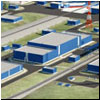 |
Facility 6: Angara's fueling infrastructure (INSIDER CONTENT) The main propellant infrastructure for the Angara rocket in Vostochny is located at Facility 6, or GP-6, which is responsible for supplying kerosene fuel to all variants of the rocket. |
||||||||
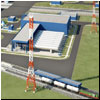 |
Facility 7: Angara's oxidizer infrastructure (INSIDER CONTENT) The GP-7 facility of the Angara launch complex was designed to handle the cryogenic liquid oxygen and nitrogen used on all the stages of the rocket family. |
||||||||
| SUPER-HEAVY LAUNCH COMPLEX | |||||||||
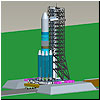 |
Launch facilities for a super-heavy rocket (INSIDER CONTENT) From the outset of the Vostochny project, Roskosmos assumed that at the conclusion of the third phase in the development of the space center, it would be able to host a super-heavy launch vehicle with a payload up to 100 tons. As of 2017, the pad for a super-heavy launcher was promised to be completed within a decade. |
||||||||
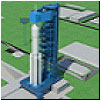 |
Super-heavy launch facility in 2019 (INSIDER CONTENT) The latest effort of the Russian industry to develop the super-heavy rocket project includes studies of the layout and architecture of the monumental launch facility capable of hosting the giant vehicle. This ongoing work saw some major movement in 2019 away from the initial concepts formulated in the mid-2010s. This section summarizes the latest status of the infrastructure design and will track its changes as it evolves over time. |
||||||||
| AMUR-SPG LAUNCH COMPLEX | |||||||||
 |
NEW, July 10: Launch facility for the Amur-SPG partially reusable rocket (INSIDER CONTENT) Starting in 2023, Roskosmos began planning facilities for the Amur-SPG rocket (INSIDER CONTENT) which was expected to include a launch pad and at least two landing sites downrange from Vostochny for its reusable first stage. |
||||||||
| START-1M LAUNCH COMPLEX | |||||||||
 |
Launch facility for light-weight Start-1M rocket (INSIDER CONTENT) In mid-2024, the survey commission completed selection of launch site for the Start-1M launcher (INSIDER CONTENT) which was to be converted from decomissioned Topol-M ICBMs as early as 2026. |
||||||||
| PROCESSING COMPLEX | |||||||||
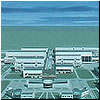 |
In Vostochny, all preparations of rockets and spacecraft before their rollout to the launch pad were to be conducted at a 104.3-hectare facility identified as Technical Area, or Tekhnicheskaya Pozitsiya, TP, located at Site 2. |
||||||||
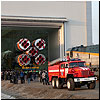 |
Rocket Assembly Building, MIK RN All types of Soyuz rockets departing from Vostochny are put together inside the cavernous Launch Vehicle Assembly and Testing Building, abbreviated in Russian as MIK RN. |
||||||||
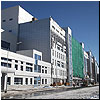 |
Spacecraft Assembly Building, MIK KA Clearly built for the future, the large spacecraft processing building in Vostochny was designed to prepare and check payloads before their integration with the launch vehicle. The the facility was directly connected to a fueling station, where satellites could be loaded with hazardous propellants. |
||||||||
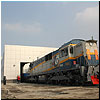 |
Storage and vacuum testing facility (INSIDER CONTENT) The original facility for storing rocket stages of the Soyuz rocket was built in Vostochny during the first phase of the spaceport's development from 2012 to 2016, but was actually used for that purpose for the first time in 2017. |
||||||||
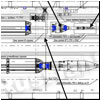 |
Processing complex for Angara rockets (INSIDER CONTENT) In addition to the launch pad, the deployment of the Angara rocket at Russia's new Vostochny Cosmodrome required the construction of the processing facility, where the vehicle's individual boosters could be delivered, checked, assembled together and undergo integrated tests in horizontal position before their rollout to the pad. |
||||||||
 |
Processing complex for Angara payloads and PTK spacecraft (INSIDER CONTENT) The planned introduction of the new-generation crew vehicle, PTK Orel, will mark the historic shift of the Russian piloted space flight from Baikonur Cosmodrome, in Kazakhstan, to the Vostochny spaceport, where a dedicated processing facility will have to be built. |
||||||||
| SUPPORT FACILITIES | |||||||||
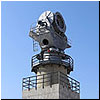 |
Like most launch sites around the world, Vostochny had to be equipped with its own network of ground stations, which would track and control space missions originating at the spaceport. The ground station closest to the launch site became known as Vostochny Command and Measurement Point or VKIP. |
||||||||
 |
The world's largest aircraft, carrying Mars-bound ships, and winged shuttles, returning from lunar missions, may one day come together at the planned airport in the Russian Far East. However before these dreams can become reality, the Vostochny airport has its most difficult mission -- to get born. |
||||||||
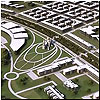 |
The 2007 decision by the Russian government to build the Vostochny Cosmodrome required a whole new city which would become a residential hub for the future space center. At the time, only a few 1960s-era apartment blocks of the former military base known as Uglegorsk ("coal town") stood at the site. |
||||||||
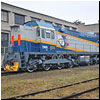 |
Support facilities (INSIDER CONTENT) To provide logistical support for the initial development and routine operations at the Vostochny Cosmodrome, Roskosmos allocated a special zone officially known as "Industrial Construction and Exploitation Base," PSEB, comprised of 32 facilities, primarily warehouses and garages. Located at Site 11, next to the residential area of the cosmodrome, the industrial zone centered around the main administrative building providing 233 offices with a total area of 16,010 square meters. |
||||||||
 |
Very early in the search for the new Russian space port in the early 1990s, experts favored the old Soviet missile base near the town of Svobodny. This remote location in the Amur Region would enable space launchers to reach a wide variety of orbits, while avoiding densely populated areas or foreign territory. | ||||||||